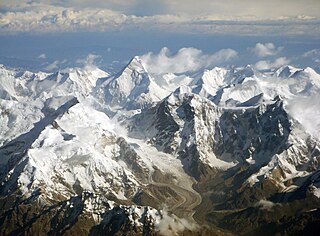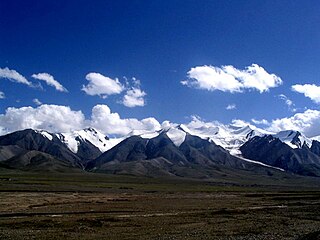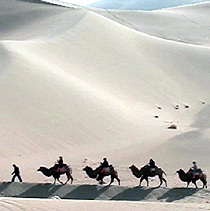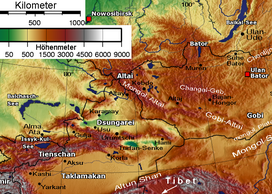
China has great physical diversity. The eastern plains and southern coasts of the country consist of fertile lowlands and foothills. They are the location of most of China's agricultural output and human population. The southern areas of the country consist of hilly and mountainous terrain. The west and north of the country are dominated by sunken basins, rolling plateaus, and towering massifs. It contains part of the highest tableland on earth, the Tibetan Plateau, and has much lower agricultural potential and population.

The Tian Shan, also known as the Tengri Tagh or Tengir-Too, meaning the "Mountains of God/Heaven", is a large system of mountain ranges in Central Asia. The highest peak in the Tian Shan is Jengish Chokusu, at 7,439 metres (24,406 ft) high. Its lowest point is the Turpan Depression, which is 154 m (505 ft) below sea level.

The Tibetan Plateau, also known as the Qinghai–Tibet Plateau or the Qing–Zang Plateau or as the Himalayan Plateau in India, is a vast elevated plateau located at the intersection of Central, South, and East Asia covering most of the Tibet Autonomous Region, most of Qinghai, western half of Sichuan, Southern Gansu provinces in Western China, southern Xinjiang, Bhutan, the Indian regions of Ladakh and Lahaul and Spiti as well as Gilgit-Baltistan in Pakistan, northwestern Nepal, eastern Tajikistan and southern Kyrgyzstan. It stretches approximately 1,000 kilometres (620 mi) north to south and 2,500 kilometres (1,600 mi) east to west. It is the world's highest and largest plateau above sea level, with an area of 2,500,000 square kilometres (970,000 sq mi). With an average elevation exceeding 4,500 metres (14,800 ft) and being surrounded by imposing mountain ranges that harbor the world's two highest summits, Mount Everest and K2, the Tibetan Plateau is often referred to as "the Roof of the World".

The Kunlun Mountains constitute one of the longest mountain chains in Asia, extending for more than 3,000 kilometres (1,900 mi). In the broadest sense, the chain forms the northern edge of the Tibetan Plateau south of the Tarim Basin.

The Hexi Corridor (Chinese: 河西走廊; pinyin: Héxī Zǒuláng; Wade–Giles: Ho2-hsi1 Tsou3-lang2, Xiao'erjing: حْسِ ظِوْلاْ, Mandarin pronunciation:[xɤ˧˥ɕi˥tsoʊ˨˩˦lɑŋ˧˥]), also known as the Gansu Corridor, is an important historical region located in the modern western Gansu province of China. It refers to a narrow stretch of traversable and relatively arable plain west of the Yellow River's Ordos Loop, flanked between the much more elevated and inhospitable terrains of the Mongolian and Tibetan Plateaus. The name Hexi, refers to "west of the river".

The Qilian Mountains, together with the Altyn-Tagh also known as Nan Shan, as it is to the south of Hexi Corridor, is a northern outlier of the Kunlun Mountains, forming the border between Qinghai and the Gansu provinces of northern China.

Golmud, also known by various other romanizations, is a county-level city in the Haixi Mongol and Tibetan Autonomous Prefecture of Qinghai Province, China. It is now the second-largest city in Qinghai and the third largest in the Tibetan Plateau. The population in 2020 is 221,863.

The Qaidam, Tsaidam, or Chaidamu Basin is a hyperarid basin that occupies a large part of Haixi Prefecture in Qinghai Province, China. The basin covers an area of approximately 120,000 km2 (46,000 sq mi), one-fourth of which is covered by saline lakes and playas. Around one third of the basin, about 35,000 km2 (14,000 sq mi), is desert.

Muztagh Ata or Muztagata is the second highest of the mountains which form the northern edge of the Tibetan Plateau in China. It is sometimes regarded as being part of the Kunlun Mountains, although physically it is more closely connected to the Pamirs. It is also one of the relatively easier 7,000 m peaks in the world to climb, due to its gentle western slope and the comparatively drier weather of Xinjiang, though a thorough acclimatization period and a very strong physical condition are crucial for success.
Ulugh Muztagh or Ulugh Muztag and Muztag Feng, is an extremely remote mountain group on the northern Qinghai-Tibetan Plateau. Located on the border between the Tibetan Autonomous Region and Xinjiang Uyghur Autonomous Region, it is part of the main range of the Kunlun Mountains of East-Central Asia.

Ruoqiang County as the official romanized name, also transliterated from Uyghur as Qakilik County, is a county in the Xinjiang Uyghur Autonomous Region, China under the administration of the Bayingolin Mongol Autonomous Prefecture. It covers an area of 198,318 square kilometres (76,571 sq mi), making it the largest county-level division in the country.

The Kumtag Desert, is an arid landform in Northwestern China, which was proclaimed as a national park in the year 2002.

The Altyn Tagh Fault (ATF) is a 2,000 km long, active, sinistral strike-slip fault that forms the northwestern boundary of the Tibetan Plateau with the Tarim Basin. It is one of the major sinistral strike-slip structures that together help to accommodate the eastward motion of this zone of thickened crust, relative to the Eurasian Plate. A total displacement of about ~475 km has been estimated for this fault zone since the middle Oligocene, although the amount of displacement, age of initiation and slip rate are disputed.

Geku railway is a railway connecting Golmud and Korla, in western China. Construction started in November 2014 and was completed in 2020. The length of the line is 1,214 kilometres (754 mi), joining Qinghai province and Xinjiang province. The investment is estimated to be CN¥36 billion. The line connects the Qinghai–Tibet railway and the Southern Xinjiang railway. It's the third railway connecting Xinjiang province with another Chinese province and the third line to Golmud after the Qinghai–Tibet railway and the 2019 Golmud–Dunhuang railway. It is part of the Taklimakan Desert railway loop, together with sections of the Hotan–Ruoqiang railway, Kashgar–Hotan railway, and Southern Xinjiang railway.
Chang Tang National Nature Reserve lies in the northern Tibetan Plateau. It is the third-largest land nature reserve in the world, after the Northeast Greenland National Park and Kavango-Zambezi Transfrontier Conservation Area, with an area of over 334,000 km2 (129,000 sq mi), making it bigger than 183 countries. Administratively, it lies in Xainza County and Biru County of the Nagqu Prefecture. With the more recently established adjoining reserves listed below there is now a total of 496,000 km2 of connected Nature Reserves, which represents an area almost as large as Spain and bigger than 197 other countries.

Altun Shan National Nature Reserve is a large, arid area in the southeast of Xinjiang Autonomous Region, on the northern edge of the Tibetan plateau and the southern edge of the Tarim Basin in northwest China. It surrounds the Kumkol Basin, an endorheic basin in the western third of the Altyn-Tagh mountains. The reserve is sometimes referred to as the "Arjin Mountains Nature Reserve", or "Aerjinshan". The reserve covers the southern portions of Qiemo County and Ruoqiang County of Bayingolin Mongol Autonomous Prefecture in Xinjiang.
Kunlun Volcanic Group, also known as Ashikule Volcanic Field, is a volcanic field in northwestern Tibet. Eight other volcanic fields are also in the area. The field is within a basin that also contains three lakes.

Dabusun or Dabuxun Lake, alternately known as Dabasun Nor, is a lake beside the town Qarhan, just north of Golmud in the Haixi Prefecture of Qinghai Province in northwestern China. Fed by the main course of the Golmud River, it is the largest present-day lake in the Qarhan Playa. Like the other lakes of the surrounding Qaidam Basin, it is extremely saline, with 307–338 grams of salt per liter of water (2.5 lb/gallon).

The Qarhan Playa or Salt Plain, also misleadingly described as Qarhan Lake, is a playa in the Golmud and Dulan counties of Haixi Prefecture, Qinghai, China. Formerly a single unitary lake, it is now an expansive salt flat divided into four greater sections which contain a number of smaller salt lakes, the largest of which is Dabusun Lake. The area is heavily exploited for its valuable salt, mineral, and rare earth reserves but parts are also protected as a national park and contribute to regional tourism.



















